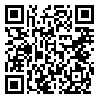BibTeX | RIS | EndNote | Medlars | ProCite | Reference Manager | RefWorks
Send citation to:
URL: http://jdisabilstud.org/article-1-2194-en.html
2- Associate Professor, Department of Psycholigy, Semnan University, Semnan, Iran
3- Assistant Professor, Department of Psycholigy, Semnan Branch, Islamic Azad University, Semnan, Iran
Abstract
Background & Objectives: Internet addiction is a compulsive obsessive behavior that completely dominates the life of the addicted person. Decision–making is one of the subjects that students face in difficult situations. The concept of decision–making style is rooted in cognitive literature. On the other hand, students use different coping styles in different situations. Coping styles are people's preferred methods to adapt to stressful situations and environments. Today, for many reasons, students use the Internet a lot. If a suitable solution is not thought of to solve this problem and the necessary planning is not done for its optimal use, it will cause them to become dependent and move away from their primary mission. So, this study aimed to investigate the role of students' decision–making styles in Internet addiction mediated by coping styles.
Methods: This research is a descriptive–correlational study. The study's statistical population included all undergraduate students of the Islamic Azad University of Garmsar, Garmsar City, Iran, in the academic year 2018–2019 (N= 718). After determining the sample size by Loehlin (2004) volume estimation method, which considered between 30 to 50 samples for each latent variable and the possibility of incomplete questionnaires, 250 students were selected by stratified random sampling method. In this study, the inclusion criteria were as follows: undergraduate students studying at the Islamic Azad University, Garmsar Branch, interested in cooperating in research, and without any mental illness. The exclusion criteria were as follows: lack of cooperation in research and becoming sick after enrollment. The following questionnaires were used to collect the data: the Internet Addiction Test (Young, 1996), the Ways of Coping Questionnaire (Folkman & Lazarus, 1985), and the Decision–Making Styles Questionnaire (Scott & Bruce, 1995). To analyze data, in addition to descriptive statistics, the Pearson correlation coefficient and statistical method of structural equations were used at a significance level of 0.05 using SPSS version 24 and AMOS version 24 software.
Results: The findings obtained from modeling structural regression equations showed that the effect of total decision–making styles on the Internet addiction was significant (p=0.044, β= 0.202). Also, the direct impacts of rational decision–making styles (p=0.037, β=–0.203), intuitive (p=0.029, β=0.104), dependence (p=0.009, β=0.404), avoidance (p=0.031, β=0.141), and instantaneous (p=0.018, β=0.125) were significant on the Internet addiction. On the other hand, the indirect effect of decision–making styles with the mediation of problem–oriented coping style on the Internet addiction was significant (p=0.041, β=–0.314). Also, the model presented in the research had a relatively good fit (AGFI=0.921, RMSEA=0.093, GFI=0.908, CFI=0.940).
Conclusion: Based on the study's results, the research's structural model fits with the collected data. Also, to explain Internet addiction among students, the variable of decision-making styles can be used with the mediation of problem-oriented coping style.
| Rights and permissions | |
 |
This work is licensed under a Creative Commons Attribution-NonCommercial 4.0 International License. |



